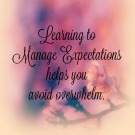- US employers lose an estimated $300 billion annually due to stress-related absenteeism, illness, and lost productivity
- 58% of Americans say work is a significant source of stress
- 36% of workers rated Workload as their #1 source of work stress followed by People Issues at 31%, Work-Life balance 20%, and Job Security 8%.
With almost 60% of Americans saying that work is a “significant” source of stress, it’s clear that we all could use a little help in trying to stay healthy, sane, and on top of our game in our fast-paced world. And because that world shows no signs of slowing down, it’s important to remember that we have more control than we know (if we’re brave enough to claim it) and ways to reduce stress may be closer than we think. With that in mind, here are five tips to managing stress on the job. Each can be used alone or in order as a cycle to help you empower yourself, beat stress, and feel more confident in the process.
Control and Deliverables
The two-headed hydra contributing the most to stress is the idea that you don’t have control over what you do and that you have too much to do. This feeling of “too muchness” from both a lack of time perspective and an avalanche of to-dos often leads to overwhelm, discouragement, and ultimately burnout.
To shift away from stress mode and into a more empowered way of working, remember that you are always 100% in control how you:
- Show up and respond to a situation
- Perceive yourself
- View your worth as a human being
- Make decisions that are best for you and others
By shifting away from what you can’t control and shifting to what you can control, you can change your response to any situation.
What you choose to tolerate or not is also within your control (we’ll get to that in a little bit in another section). When you decide to take back your power you ultimately affirm yourself as the creator of your life and your situation so focus on what you can control and work that like a boss.
Having “too much to do” is a common issue in today’s workplace. Restructuring, downsizing, and losing positions to attrition and retirement have forced many to take on the work of others in addition to their own responsibilities.
One way to sort out the too-muchness of your deliverables is to not only look at value but at why you’re doing what you’re doing. So many times we have been convinced that everything is a top priority and has to be done or the world is going to implode…and it’s nonsense…because we know better. Everything isn’t critical, and (I boldly assert) that doors will not close and bankruptcy will not be declared if a particular subset of tasks is pushed to a later due date.
One of the best things you can do with your precious time and energy is to
determine what is most important, and then focus only on those items.
By focusing on value-add and items of genuine importance, you not only feel better about what you accomplish, but you again take back a sense of control over what you are doing. Will you feel better about hammering out those high-value projects or staying stressed about miscellaneous tasks that really could be pushed off until later?
Define Your Role
A second tip for managing stress is to better define your role. Sometimes we think we know what we’re supposed to be doing and why but it never hurts to have the conversation. You can do this by:
- Clarifying what your role is for each project you are assigned instead of assuming you know what that role is
- Clarifying what role others play in a project
- Looking at each project or task you have and determining if you are the lead or the support.
- Seeing if what you’re doing is also being done by someone else, therefore resulting in duplicate work that can be eliminated
Lastly, when defining your role, ask yourself what you would like that role to be. If you’re the support and want to be the lead, see if you can work yourself into more of those types of roles and having specific conversations about how you can transition your support projects away.
Work Your Work Style
It can be truly frustrating to be the only person on your team or in your department who likes to plan and stay organized. If you’re surrounded by others who excel at working on the fly when they’re under pressure, and their hair is on fire, you’re going to feel undue pressure to do the same. In many instances, you may be required to do the hair-on-fire work routine because you’re dependent on others for information or decisions.
By knowing and working your work style, you stand a much better chance at managing stress and getting more work done more productively. Have the conversation with your superior and your coworkers; ask everyone to share how they work best and why. You’ll learn about each other and may figure out ways to help one another in the process. If you are that person who plans and organizes, see what you can do to make your piece of the puzzle more efficient and contingency plan for the inevitable fire drills that you know will come your way.
Set Effective Boundaries
One of the most significant ways to help with stress is to establish effective boundaries first with yourself and then with others. Setting boundaries can be scary (and so empowering) because it requires you to know yourself and know what you need (notice I didn’t say what you want). Understanding yourself and your needs are critical for meeting goals at work and living a healthy and fulfilled life. Once you know what you need, you can plan the conversations you need to have to start working toward meeting those needs.
I’ve written about setting boundaries HERE, but I’d like to add one additional thing:
If you do not set boundaries for yourself, others will set them for you
and the boundaries others set for you may be for their benefit, not yours.
We all show others how to treat us a) by how we treat ourselves and b) what we tolerate so make sure you’re treating yourself as an example of what you expect from others.
Boundaries are the ultimate form of self-care and self-respect; without them, we set ourselves up for unnecessary stress and suffering. Boundaries can be set around:
- The amount of work you can accomplish
- The amount of time you will spend working overtime
- The role you will play for a specific project
- How much you will alter your work style to accommodate others
Setting boundaries is powerful. It shows others that we respect ourselves and others.
Monitor Your Health and Make a Plan
The last tip for managing stress is to monitor your health. And I don’t just mean how your body feels, but how you feel emotionally and mentally as well. We can be our own worst enemy when it comes to our health; we sometimes force ourselves to run on next to no sleep or to stay wired on caffeine to get the job done. Over time, this is a recipe for disaster. The good news is, we can be our own best advocate by listening to what we need: physically, mentally, and emotionally.
If you’re in a work situation that has become toxic and had led to severe long-term stress, take the bold step of asking yourself why you’re staying. Changing jobs can in itself be stressful, but if you’re in a place where you are no longer functioning well, please consider pulling the plug. Remember that you are capable, hard-working, and have marketable skills; in other words, have confidence in yourself. No one cares about you more than yourself, and you owe it to yourself to be in a place that values you and your health.
Workplace stress remains a constant in our ever-evolving world. By focusing on what you can control and working on high value-add projects, you can better manage stress and feel more satisfied with what you do each day. Defining your role and working your work style both help you get the job done effectively and efficiently. Setting boundaries and monitoring your health allow your needs to be met and show others that you respect them, but you also respect yourself.
Please drop me a note in the comments about how you manage stress on the job. I’d love to hear from you.
Remembering also that what one person finds stressful another may find challenging yet rewarding
For more stats and to see the source of the stats in this post head to: https://www.meditationatwork.com/blog/stats-facts-about-work-stress-to-consider-in-2018-infographic





